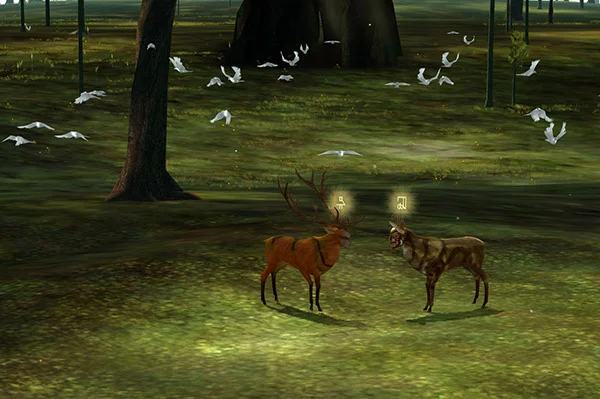The Black Pot
Nathalie Djurberg, a Swedish stop-motion animator, molds and manipulates clay figures to tell interesting narratives. The Black Pot, a video and sculpture installation abstractly visualizes the essence of life in its most primitive form. Djurberg creates a series of multi-colored circles with cell-like behavior to depict a scene from the beginning of the universe. The sculptures of eggs broken and full alike serve as metaphors for the controversy of where life began. The claymation videos featured in the installation are meant to inspire intense pondering within the spectators on how “things” come into existence. The installation is set up in a dark room. Three claymation videos play simultaneously on a wall, while a more illustrative style of animation plays on another to visualize the process of cells splitting. The first claymation video is of a black woman wrestling with snakes that change masks after biting off each other's faces. The second is of a white family sitting down at the dinner table when their food comes to life and begins attacking them. The third is of a witch like figure and crocodile digging for an egg which they then fight over once it is uncovered. The illustrative animation looks like a crayon drawn animation of colorful circles that split and join together to form different shapes and sizes. Each of the videos involve an intense use of color with very simplistic means of creating each of the images- very minimal realism. Spectators enter the room and observe the work while comfortably sitting on the egg and donut statues arranged in a circular pattern on the floor. In a more succinct description from Lisson Gallery:
“The central video installation takes the shape of a circular panorama where symbols of universal creation take on a very personal and poetic note. As in a bubbling pot, sublime and earthy senses mix in the dark space of the universe. The exhibition also features new work by the artist, including sculptural seats that take the shape of everyday items, such as donuts or scrambled eggs. These are formally united in a circle—the primary symbol of the creation of the world.” Feuer, Zach (2013, 21 June) Nathalie Djurberg & Hans Berg
A review in art agenda magazine states:
“The Black Pot showcases the artists’ experimentation with newly abstracted animations and ambient electronica within a darkened, womb-like environment, in order to depict the cycle of life. Sponsored by the Detroit Institute of Arts (DIA).” (2014, 26 September) DLECTRICITY
Djurberg's work usually consists of shocking stories of nightmarish illusions. Her intriguing pieces often find spectators dumbfounded, trying to fully grasp the hellish imagery they witness. The dividing cell animation aspect of this piece refreshingly breaks away from Nathalie’s previous works of claymated terror. This original "sloppy" style of claymation Djurberg adapts brings light to the idea of what conceptually would change if her animations were more realistic and elaborate. This is the conversation Djurberg keeps open by creating barbaric images with a touch of simple, almost-childish construction. The concept of The Black Pot presents an idea that without a doubt every artist has come across a multitude of times in their career- where do my ideas, my inspiration, my motivation originate from? From where do all things derive? It is important to continue conversation about existence to inspire not only artistic but scientific exploration on the matter.
In comparison to Djurberg’s other work, “The Black Pot” definitely takes a calmer approach to creating a story to the conversation at hand. For example, in her piece Watch Me Move: The Animation Show (pictured above), Djurberg forms an obese woman who ironically gives birth to a rhinoceros and the two share awkward interactions until a male figure emerges and gives birth to a chimpanzee. The painful process watching a baby rhino escaping from the vagina of a swollen lady and then a chimp coming from the anatomy of a man surrounds the audience in an inescapable nightmare of discomfort and fear. These sort of grotesque images provide a strong juxtaposition to dancing bubbles and hand crafted donut seats featured in “The Black Pot”. However, it is the dark fantastical scenes Djurberg so successfully creates that establishes her art as wickedly brilliant.
Djurberg’s work also shares qualities of Allison Schulnik, a claymator, who creates naïve yet complex images out of clay. In her work, “Mound”, Schulnik mixes paints, illustration, and clay to create a complex scene like Djurberg includes in her blobby paint cells and Claymation projections. "Mound" is an extremely eerie gathering of constantly deforming pale human like figures. The ghost-like figures that moan and distort in Schulnik's piece also reflect the dark vibes that resonate in Djurberg's claymation artworks.
“The Black Pot” was exhibited at the Garage Center for Contemporary Culture in Moscow, Russia
Additional Press:
http://thecreatorsproject.vice.com/blog/allison-schulnik-pushes-claymation-to-its-psychedelic-limit







